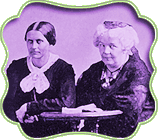|
Although the activities in the kids area of the "Not For Ourselves Alone" Web site are designed primarily for informal, at-home use by kids, they can also be great supplements for classroom instruction in grades 3-6. Read on to discover how you might incorporate these activities into your curriculum!
A Day In The Life:
This activity is structured as a "choose-your-own-adventure" game. Kids adopt the persona of a child living in the 19th century (one of five different characters) and go through a typical daily routine by answering quiz questions. The questions include information about that child’s education, recreational activities, home life, and more.
Teachers interested in incorporating this game into their classroom instruction might consider one of the following ideas:
- Use the game as a follow up or accompaniment to a reading club. Students might read works including:
- American Indian Children of the Past
- American Indian Fairy Tales
- How Would You Survive as an American Indian?
- Brave Bear and the Ghosts: A Sioux Legend
- If You Lived with the Sioux Indians
- My Heart is on the Ground; The Diary of Nannie Little Rose, a Sioux Girl
- Moonstick : The Seasons of the Sioux
- The Irish American Family Album
- Paperboy (Irish immigrant in 19th century New York City)
- So Far from Home : The Diary of Mary Driscoll, an Irish Mill Girl
- Caleb’s Choice (slavery and the Fugitive Slave Law in Texas)
- Come Morning (slavery)
- Slavery Time When I Was Chillun
- Daily Life in a Victorian House
- Samantha: An American Girl (Victorian New York)
- Across the Wide and Lonesome Prairie : The Oregon Trail Diary of Hattie Campbell
- Mississippi Mud : Three Prairie Journals
- Little House on the Prairie
- Students could compare how the accounts differ in different forms: novels, diaries, reference works. Also, they could compare how the information in the books differs from the information given in the game.
- Use the game as a model for other time periods. Students might construct their own game with characters during colonial times, during the Great Depression, etc.
- Use the game as the beginning of a discussion focusing on the rights and opportunities for children in America today. How does the experience of the characters in the game differ from your students’ own experiences? What opportunities do they have that didn’t exist for children in the past? What opportunities should all children have? This could lead your students to submit their ideas in the Kids Bill of Rights forum area of this site.
Kids Bill of Rights:
The Kids Bill of Rights submission area invites kids to send in their ideas about these questions: Do kids deserve the same rights as other citizens? What rights should they have? The top ten “amendments” submitted will be incorporated into a Kids Bill of Rights to be posted on this web site.
Incorporate this into your classroom activities by trying one of the following:
- Read the Bill of Rights and discuss which of these rights should apply to kids. Are all these rights appropriate for kids? Why? Discuss the connection between rights and responsibilities. What responsibilities should go with the rights listed in the Bill of Rights?
- The United Nations has a special Committee on the Rights of the Child which advocates for the basic rights of children worldwide. Older students (and teachers) may gain a lot of background information by visiting the UN site. Younger children might pick a country and learn about the daily life of children in that country. How would children in that country feel about the Kids Bill of Rights posted on this site? Students might also find a pen pal in another country by visiting sites like E-Pals.
- Find out how children are protected in your area by having someone from social services or the local judicial system speak to your students. Under current law, what are a child’s basic rights?
Photo Gallery:
Can your students imagine what it was like to be a kid 100 years ago? The photo gallery features ten pictures of kids in the 1800s golfing, playing in Central Park, and more.
Incorporate this into your curriculum through creative writing exercises. After students view the images on the site, ask them to choose one of the characters and write a story or poem from that person’s perspective. Where is this person? How do you think he feels, and how can you tell?
You can also use the activities for studies of sound; have students create captions for the photos that are tongue twisters or rhymes. These can be printed out and displayed in the classroom.
Take Action:
The suggestions in the "Take Action" section of this site are perfect ways to get your students involved in being good citizens and to increase their awareness of other people in the community. Students organize food, clothing, and/or toy drives for the needy, tutor others, and write letters to local officials.
If your students have other ideas for this section, send them in! We’d love to hear from you.
|









